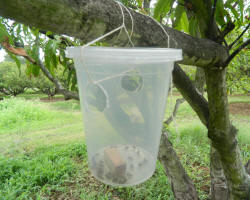Mango fruit fly trap
 Mango,
the king of fruits, has a great export potential due to
exquisite taste and flavor. Our country ranks first in
area and production of mango with 2.31 million ha and
12.75 MT, respectively. But infestation with oriental
Fruit Fly (Bactocera dorsalis) has been a major
impediment to mango export. It accounts for about 27
percent of the harvesting loss. Mango,
the king of fruits, has a great export potential due to
exquisite taste and flavor. Our country ranks first in
area and production of mango with 2.31 million ha and
12.75 MT, respectively. But infestation with oriental
Fruit Fly (Bactocera dorsalis) has been a major
impediment to mango export. It accounts for about 27
percent of the harvesting loss.
A simple, eco-friendly, cost-effective trap developed by
the Indian Institute of Horticultural Research,
Hessarghatta, Bangalore has come as a respite for mango
exporters and growers across the country. The trap has
resulted in increased yield and better returns to the
mango growers. Field trials in mango orchards have shown
encouraging results in the Integrated Pest Management
(IPM) System.
The trap works on a simple Male Annihilation Technique
(MAT). The trap consists of a small plastic container
with a piece of plywood treated with methyl eugenol and
dichlorovos which in hung on the tree. This trap
attracts the male fruit fly. In the absence of males,
females fail to procreate and hence the fruit will be
free from infestation. Six to eight traps are required
for each acre.
There is substantial decrease in losses consequent to
adoption of this technology. This has facilitated export
of mangoes to several countries like USA, Japan, New
Zealand and Australia which had previously banned Indian
Mangoes because of fruit fly.
Indian Institute of Horticultural Research is in the
process of patenting this farmer friendly technology.
|